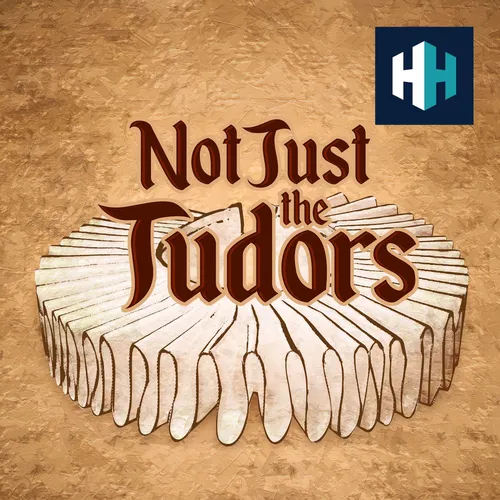
Not Just the Tudors
Professor Suzannah Lipscomb talks about everything from the Aztecs to witches, Velázquez to Shakespeare, Mughal India to the Mayflower. Not, in other words, just the Tudors, but most definitely also the Tudors.
Each episode Suzannah is joined by historians and experts to reveal incredible stories about one of the most fascinating periods in history, new releases every Wednesday and Sunday.
A podcast by History Hit, the world's best history channel and creators of award-winning podcasts Dan Snow's History Hit, The Ancients, and Betwixt the Sheets.
Sign up to History Hit for hundreds of hours of original documentaries, with a new release every week and ad-free podcasts. Sign up at https://www.historyhit.com/subscribe.
Hosted on Acast. See acast.com/privacy for more information.
- Update frequency
- every 3 days
- Average duration
- 42 minutes
- Episodes
- 459
- Years Active
- 2021 - 2025

Marie Antoinette
In 1770, 14-year-old Archduchess Maria Antonia of Austria arrived in France to marry Louis XVI. As Marie Antoinette, she became the ultimate diva of her time; rebelling against the the rigid protocol…

Elizabeth I & the Sultan of Morocco
Elizabeth I and Sultan Ahmad al-Mansur of Morocco shared a common goal of empire building, despite their cultural, political and religious differences. Their alliance resulted in the transformation o…

William III & the Persecution of Sodomites
**Warning: This episode contains explicit descriptions of sexual acts and the use of historic terminology that does not align with current usage**
The first widespread discussion of sodomy in public d…

Majestic Mughals: From Akbar to Shah Jahan
Beginning with the reign of Emperor Akbar and continuing through to Shah Jahan, India's Mughal Empire enjoyed fabulous wealth and stable governance, resulting in remarkable artistic achievements, inc…

The Witches of Lorraine
**This episode contains brief descriptions of tortures**
Between 1570 and 1630 there was intense persecution as thousands of people were accused of being witches in Lorraine, a small duchy on the bord…

The Women who Painted the Tudors
We probably think that the only artists working in the Tudor court were men, like Holbein and Hilliard. But new research is revealing that women were painting the Tudors too, and they were probably m…

Practical Magic: Spells, Prayers & Cunning Folk
Long before witch trials, magic was the domain of ‘cunning folk’ who were part of the fabric of medieval and early modern life. Their charms, filters and spells - for personal advancement, aiding fer…

Leonardo da Vinci with Ken Burns
Leonardo da Vinci was a man like no other. A restless visionary and polymath, his paintings are some of the best known of all works of art.
To talk about Leonardo, Professor Suzannah Lipscomb is joine…

Witchfinder General
In the aftermath of the Civil War, a remote corner of Essex witnessed the most brutally devastating witch-hunt in English history. A dangerous maverick Matthew Hopkins, 'the Witchfinder General', hun…

Invisible Activists of the Reformation
The names that spring first to mind in the Reformation of Christianity tend always to be male. But women were central to these extraordinary transformations in religious life in Europe and around th…

The Witch
Join Professor Suzannah Lipscomb and Professor Ronald Hutton as they explore the evolving definitions of witches, the global spread of witch beliefs, and their impact during the 16th and 17th century…

Fireworks: From the Tudors to Guy Fawkes
A pyrotechnic dragon roared flames into the river Thames during the coronation week of Elizabeth of York in 1487. These explosive displays were employed as a sign of might and majesty throughout the …

The Brutal Basque Witch Hunt
In 1609, some 80 people were executed for witchcraft in France's Basque region. It inspired a final push to eradicate witches by the Spanish Inquisition across the border. One of the judges, Pierre…

Africans in 17th Century England
In the 1640s, Black communities existed in London and in most of England's port cities, communities from which men would fight and die throughout the English Civil War. There's still little evidence …

The Tudor World at Hampton Court
The oldest surviving part of Hampton Court Palace is a series of chambers and closets built in the 1520s for Henry VIII's chief advisor and Lord Chancellor, Cardinal Wolsey. They are now the setting …

The Spanish Armada
In July 1588 the Spanish Armada set sail to conquer England. Three weeks later a fierce naval battle foiled the planned invasion. Many myths surround these events. The "genius" of Sir Francis Drake…

Henry VIII's Brothers in Armour
Henry VIII loved the spectacle of a tournament to show off. In addition to jousting displays with François I of France, Henry and the Holy Roman Emperor Maximilian I gifted each other armour and jou…

Oliver Cromwell: Massacres & Manoeuvres
How did Oliver Cromwell navigate the many forces ranged against him and rise to the pinnacle of his power? From the execution of Charles I, through the establishment of the Commonwealth, to savage c…

Elizabeth I's Conjuror: John Dee
A trusted advisor to Queen Elizabeth I, Dr. John Dee was an astronomer, mathematician, astrologer, and navigator with ties to the occult.
But what role did astrology or the occult have alongside Chris…

Floral Messages in the Tudor Court
The Tudor Rose was a well-known symbol which dominated the national identity of England. But for both the Tudors and Stuarts, flower imagery flourished across all aspects of the arts as well as in da…